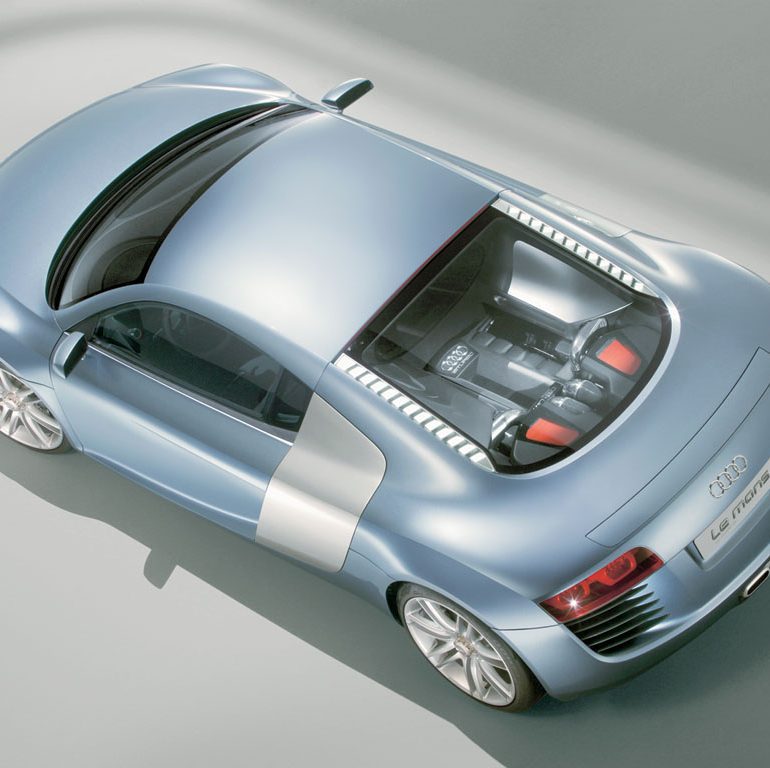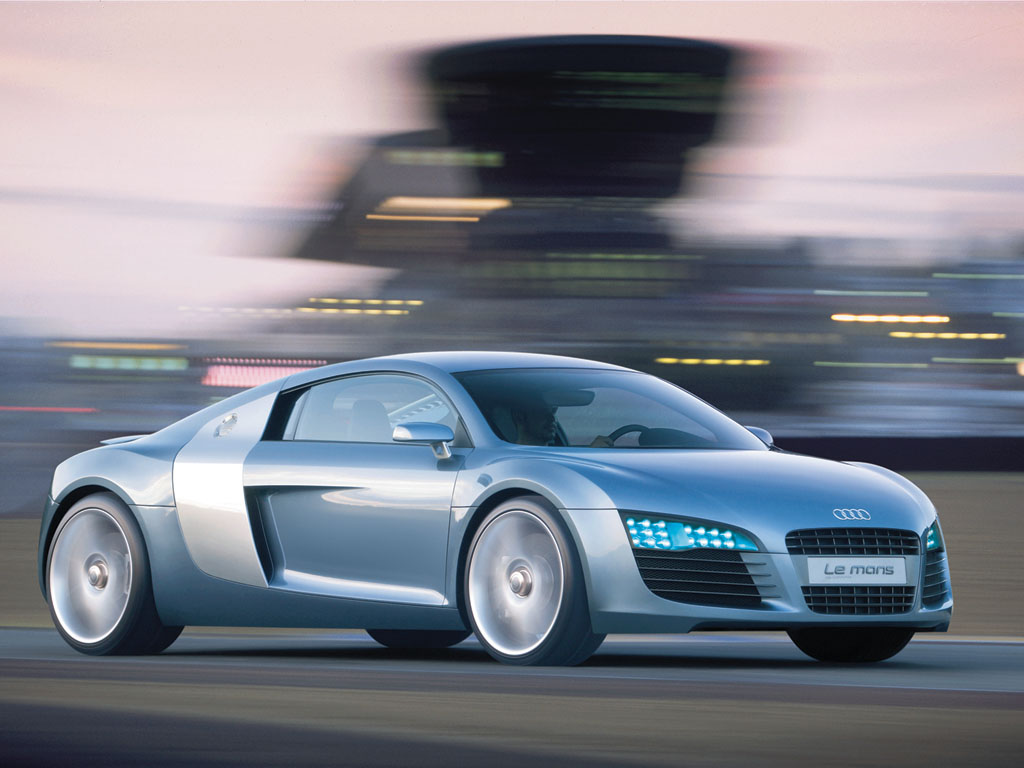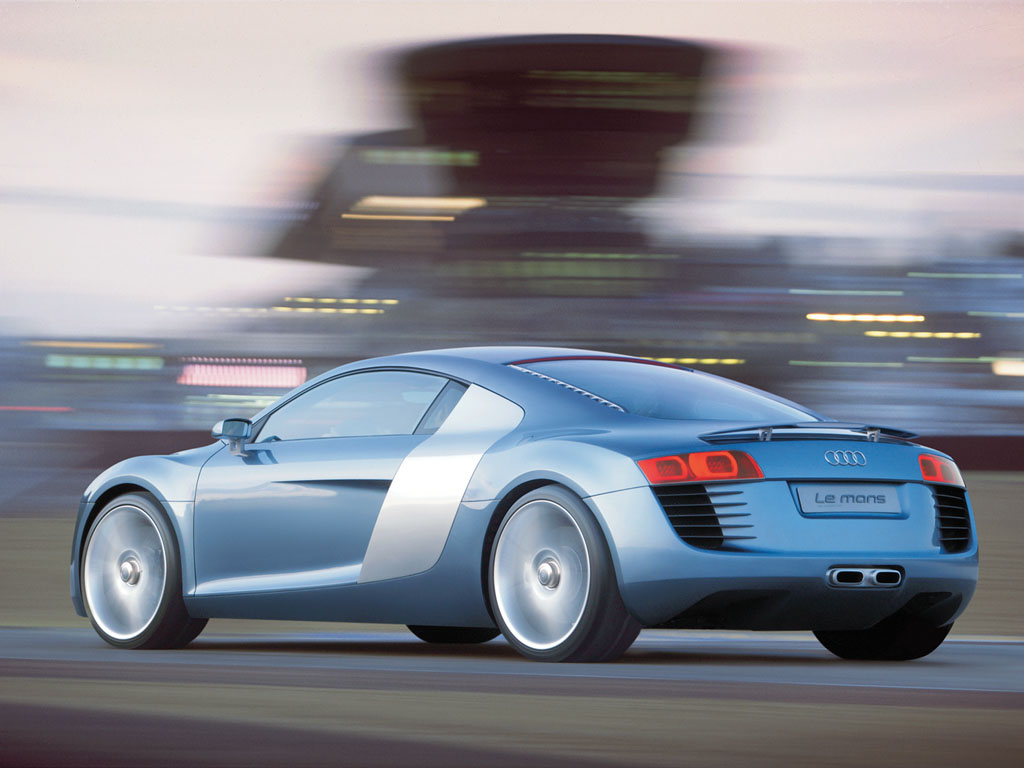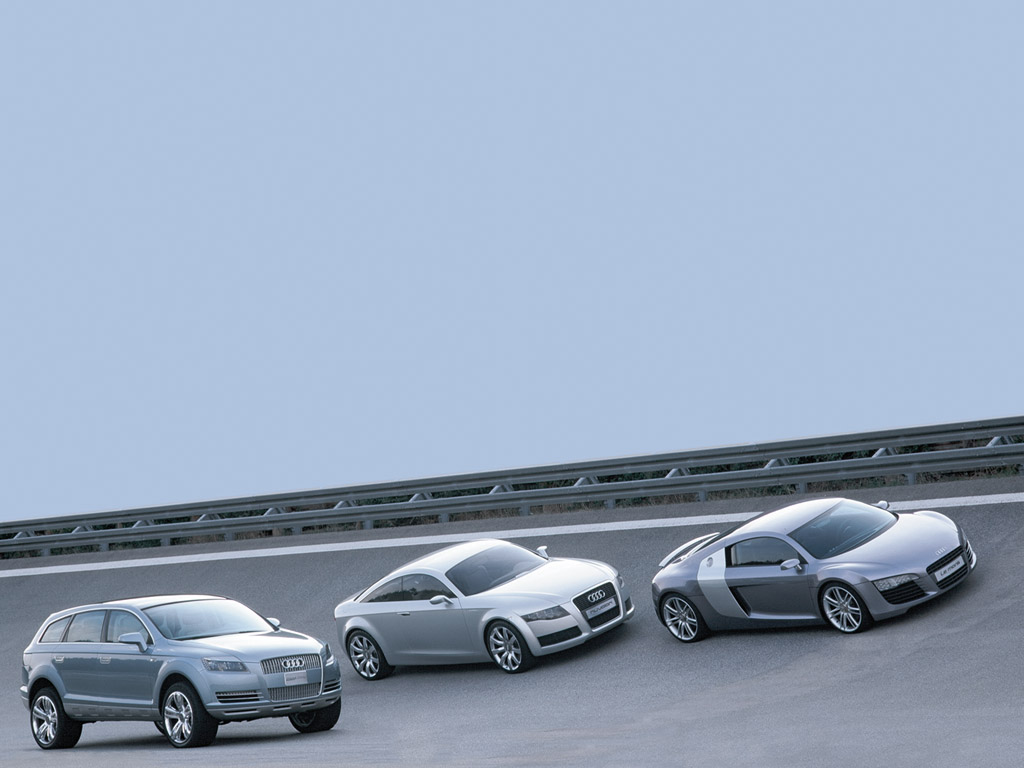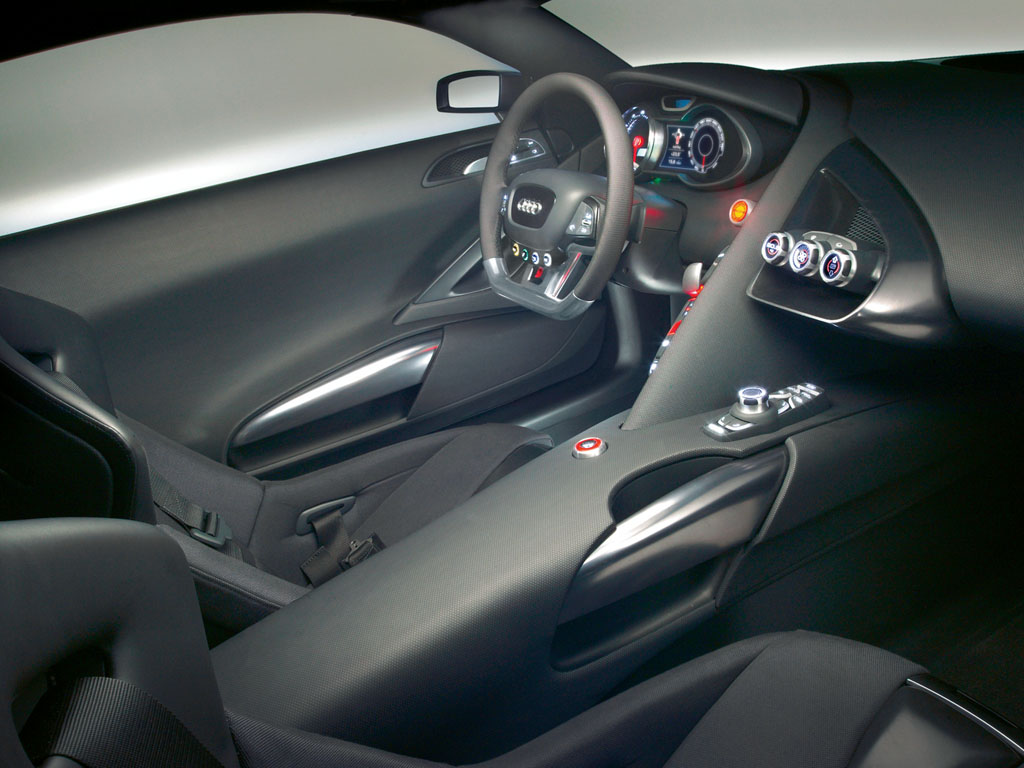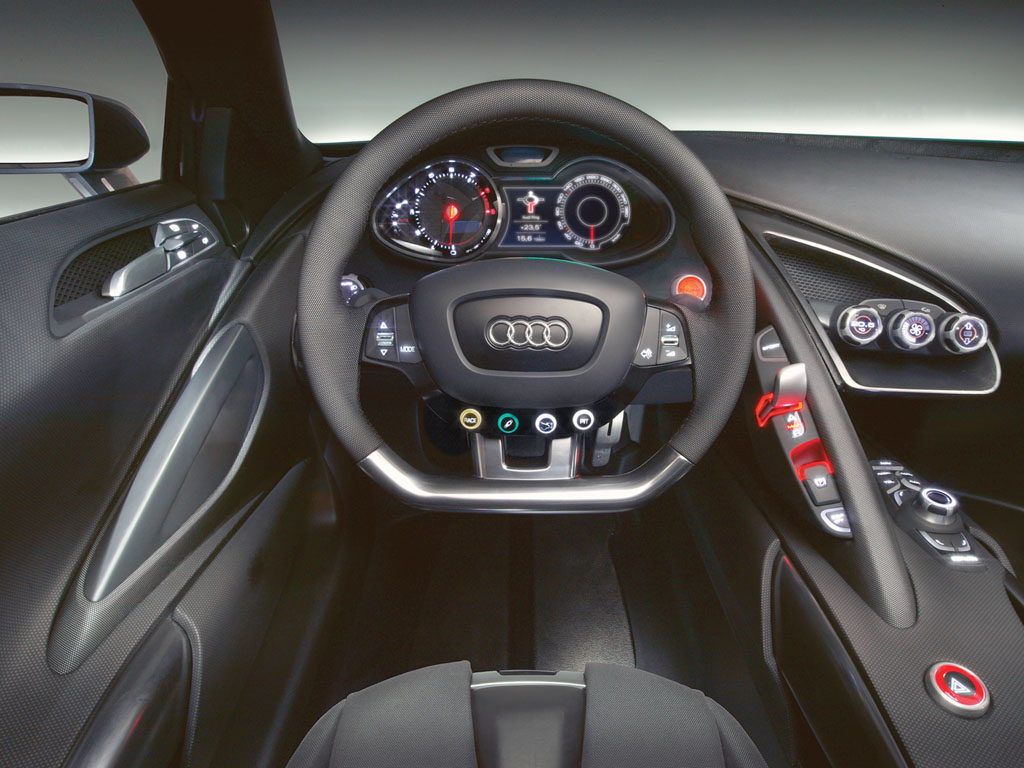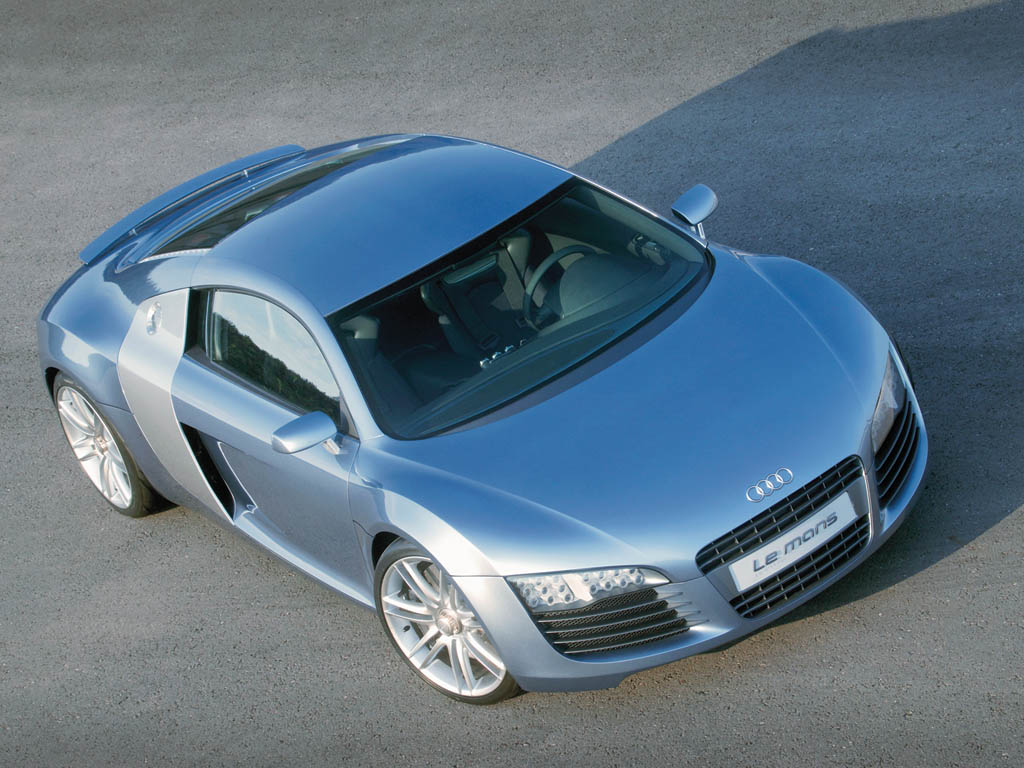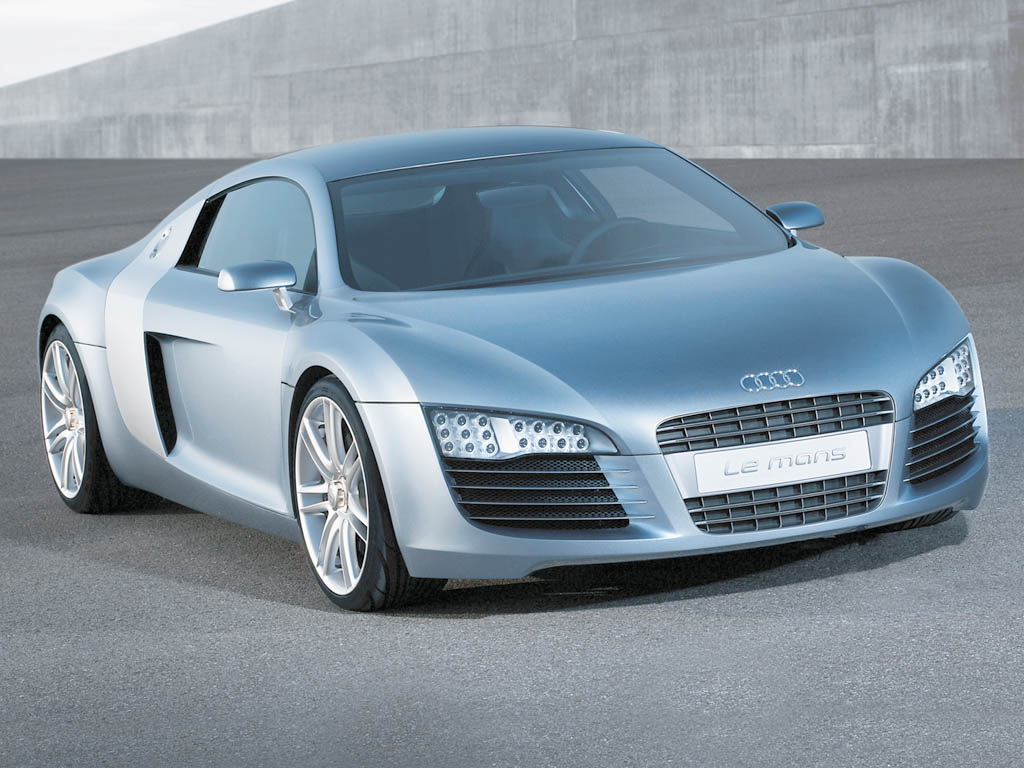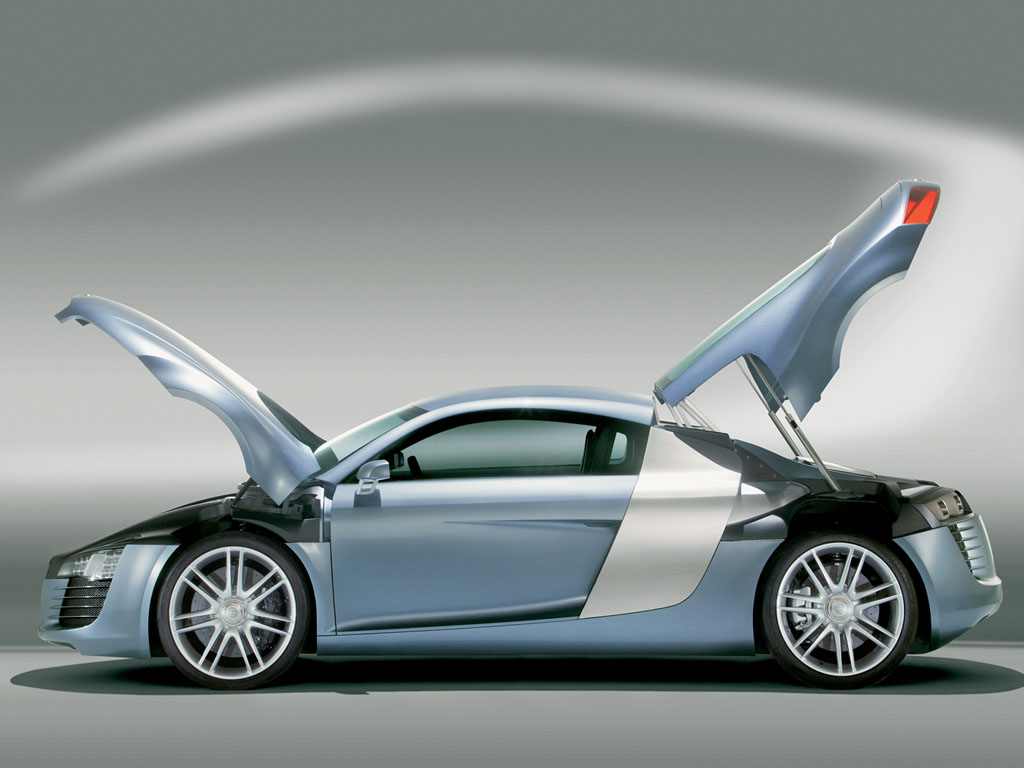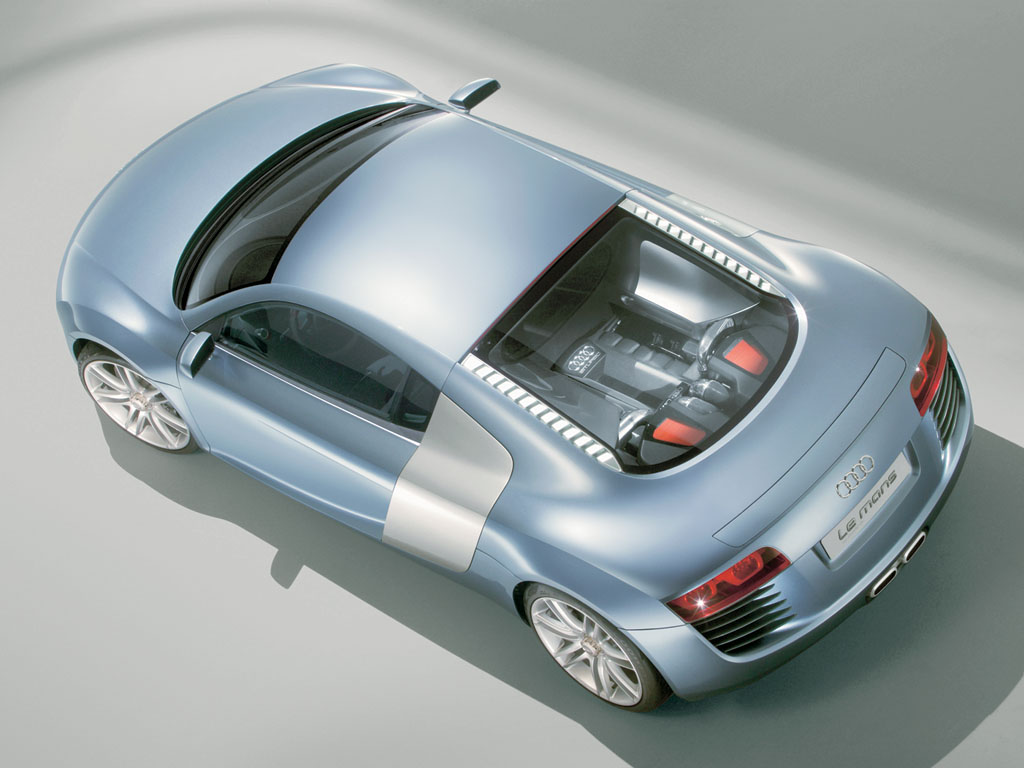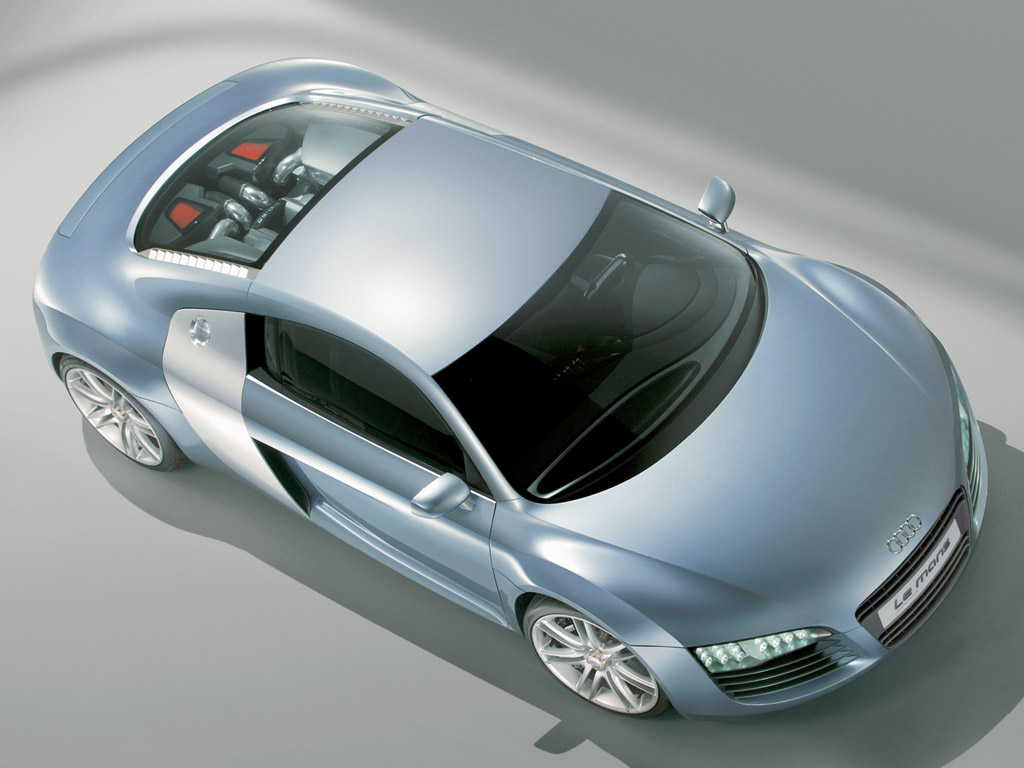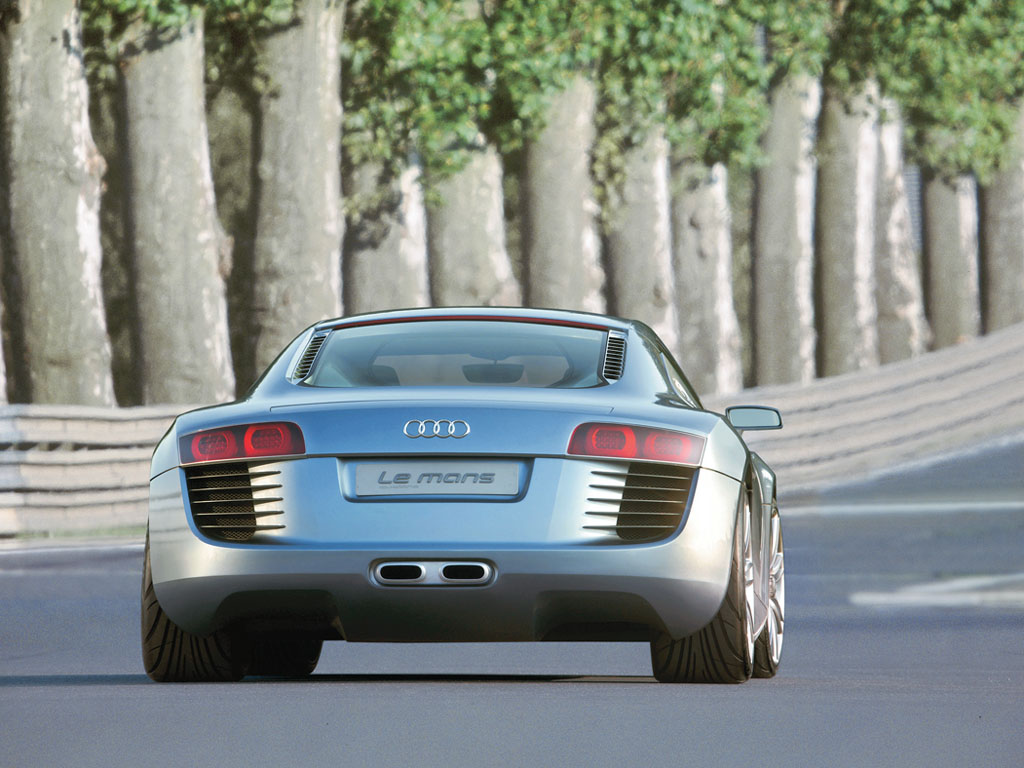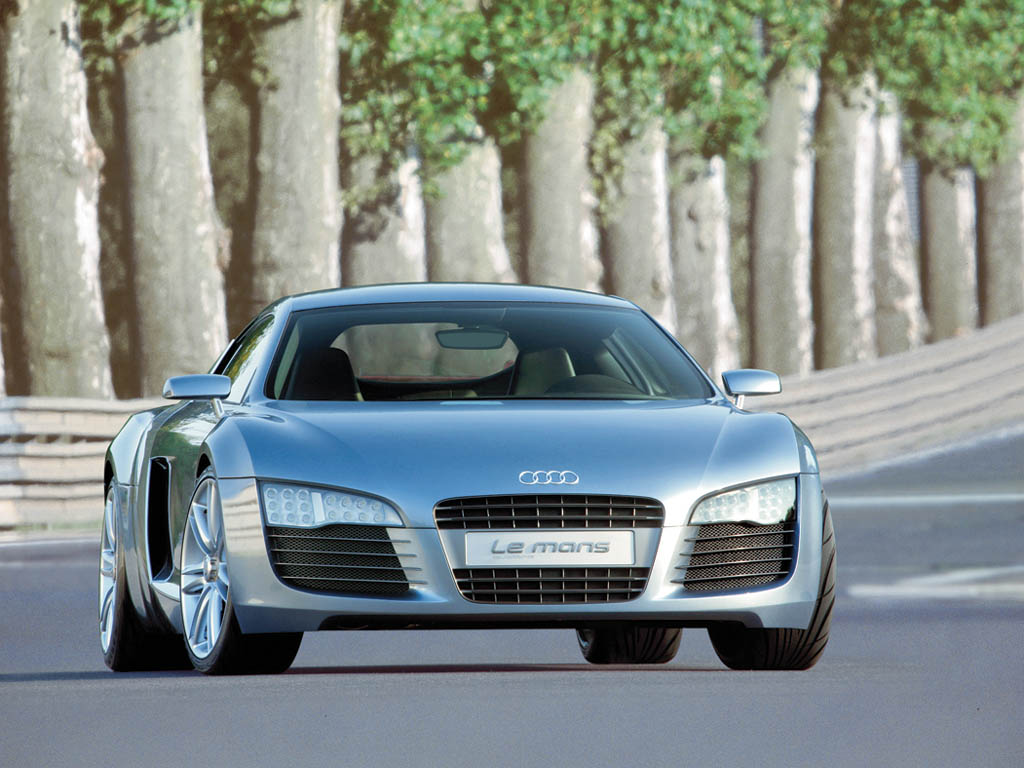2003 Audi Le Mans Quattro Concept
A high-performance sports car, a roadgoing vehicle that could be said to have inherited the genes of the Audi R8, three-times winner of the Le Mans 24-Hours race: Audi reveals its Le Mans quattro concept study.
This fascinating driving machine is a synthesis of the experience gained from numerous racing triumphs, allied to advanced design and Audi’s technical competence – which has in turn become synonymous for Audi’s technological leadership (Vorsprung durch Technik) on the racetrack and the road alike.
610 HP Engine
A flow of power as if from a turbine, a high maximum torque curve and a fascinating sound: the basic features of a perfect sports-car engine. This 5.0-litre V10 engine with its twin turbochargers is just as fascinating in the potential it offers as in its suitability for day-to-day use. Its bite in every operating range and its unrivalled willingness to rev up to high speeds are truly impressive.
This ten-cylinder engine has 40 valves, operated by four overhead camshafts. Both the inlet and exhaust valves have continuously variable opening periods to ensure optimum gas flow in all engine-speed ranges.
Two turbochargers driven from the exhaust and located behind the engine boost the pressure of the combustion air to a maximum of 2.0 bar before it is forced into the engine. The charge-air intercoolers are mounted above the engine. They are fed with air through an inlet on the body side and have an additional low-temperature cooling water circuit. The two oil coolers are at the side of the engine, well positioned in the airflow behind the side inlets.
As a result of these careful design measures, the engine can develop an impressive 449 kW (610 bhp). A big contribution to this formidable output is made by the direct petrol injection (FSI) system, which set new standards in the cars that won such historic victories in the 2001 and 2002 Le Mans races and in the American Le Mans Series. FSI combines outstandingly efficient power output with highly efficient combustion of the fuel.
In the Audi Le Mans quattro the ten-cylinder biturbo FSI engine is particularly pleasant on account of its willingness to rev freely and its lusty pulling power at all engine speeds. The maximum torque of 750 Newton-metres is available within an exceptionally broad engine-speed range from 1,750 to 5,800 rpm, so that unnecessarily frequent gear changes are avoided.
4WD
Such a powerful Audi car naturally features the quattro permanent four-wheel drive system. The Le Mans quattro, as a leading-edge technology carrier, has a version of this legendary driveline that has been adapted to suit the car’s mid-engined layout and the associated axle-load distribution.
For optimal traction and dynamic road behaviour, the power from this mid-engined sports car’s ten-cylinder engine is normally distributed in a ratio of 40:60 between the front and rear axles. This achieves maximum agility together with optimal traction – essentials for supreme road dynamics in all conditions and on corners of varying radii.
This version of the quattro driveline, with Torsen C inter-axle differential, is of course capable of diverting engine torque to the axle at which there is more tyre grip available, in order to suppress wheelspin. Depending on the amount of grip detected, torque distribution between the front and rear axles can be varied continuously from 20 : 80 to 70 : 30 percent.
Chassis
The suspension uses double wishbones at front and rear; the upper and lower front wishbones are both triangulated. At the rear, the upper wishbone is triangulated and the lower one is of a trapezoidal pattern for optimal wheel location – a geometry that has proved ideal for maximum steering precision and precisely defined self-steering effects in motor sport.
Direct-action rack and pinion steering with the degree of power assistance dependent on road speed reduces steering wheel effort while ensuring an optimal level of feedback from the road.
The spring and shock absorber settings are firm, to ensure the highest possible level of road dynamics, but the level of ride comfort that they offer is none the less most remarkable. This is because the shock absorbers feature an innovative technology known as Audi magnetic ride. Instead of the conventional hydraulic fluid in the shock absorber, it contains a magneto-rheological fluid, the viscosity of which can be varied by applying a magnetic field. The electronic control system energises an electromagnet which can be used at any time to influence the shock absorber’s operating characteristic.
In this way the most suitable level of damping can be provided in every driving situation, for optimum ride quality and dynamic road behaviour. A computer uses signals from sensors to detect the actual driving situation within a few thousandths of a second. A switch is provided at the steering wheel for the driver to choose between two driving programmes, either an emphatically sporty one using the magneto-rheological shock absorber fluid at low viscosity, or the alternative setting for greater ride comfort.
Yet another high-tech feature adopted from motor sport: the brake discs are made from a ceramic material. With diameters of 380 mm at the front and 356 mm at the rear, they slow and stop the car in a manner that matches its immense performance. Braking pressure is transmitted to these discs by eight-piston fixed calipers at the front and fist-type calipers at the rear.
The ceramic material used for the brake discs conducts heat away excellently, withstands high temperatures very well and is therefore exceptionally resistant to fading: a most desirable feature that will enable the Audi Le Mans quattro to achieve the fast lap times of which it is capable on the world’s racing circuits.
Exterior Styling
Even the first glimpse of the car gives the observer a clear picture of its calibre. The Audi Le Mans quattro, with its Jet Blue paint finish, has a wide stance and a bullish appearance on the road. Its powerful rear end seems to be bracing its muscles in order to jump, like a sprinter on the starting line.
The body makes a compact impression. The car’s front and the flat curve of the roof outline seem to have been sketched with a single sweeping stroke: a line that identifies the two-seater instantly as an Audi, since together with the front curve of the front wings it recalls the Audi TT and the Nuvolari quattro GT study.
The Audi Le Mans quattro is a markedly cab forward design, typical of a mid-engined sports car and with visible echoes of the Audi R8. Behind the occupant area but ahead of the rear axle is the V10 engine with its twin turbochargers: a technical sculpture that is visible from the inside of the car and also through a large, transparent rear flap.
1.90 metres wide but only 4.37 metres long and 1.25 metres high: those are the proportions of a supersport model. The 2.65 m long wheelbase accommodates a remarkably spacious occupant area and the longitudinally installed engine behind it. To the rear of the doors, between the sill and the roof, there is a large outward-curving intake that supplies the V10 engine, the oil cooler, the charge-air intercooler and the brakes with sufficient air.
The base of the rear end in particular exposes certain technical features of the Audi Le Mans quattro, among them the two central exhaust tailpipes and two large diffuser openings that reveal the intensive influence of aerodynamics on the car’s design.
Body aerodynamics were developed in Audi’s modern wind tunnel, in close cooperation between Audi Design and Audi Sport. These two sections of the Audi organisation have already worked on three generations of the Audi R8 competition car, preparing it for road speeds of well over 300 km/h and optimising its aerodynamic downforce for fast, safe cornering – technology transfer at the very highest level.
When the Audi Le Mans quattro is driven at a speed above 120 km/h, its rear spoiler is extended automatically into the slipstream, to add to the negative lift generated by the aerodynamic design of the floor pan and the diffusers. If the driver wishes to leave the spoiler extended all the time, for instance when lapping a racing circuit, it can be prevented from retracting at a button on the multifunctional steering wheel. Otherwise it moves back in again flush with the body when the Audi Le Mans quattro’s speed drops below 80 km/h. Incidentally, the spoiler is also extended when the car is reversed, since it contains the strip-pattern reversing lights.
This concept car is based on aluminium Audi Space Frame (ASF) structure – the perfect blend of minimum weight and maximum rigidity as a foundation for the highest standards of road dynamics.
The outer skin of the body and various add-on parts are of mixed weight-saving construction, using aluminium and carbon-fibre reinforced plastics. This is a precondition for the car’s low gross weight of only 1,530 kilograms and therefore for its outstandingly good power-to-weight ratio of only 2.5 kg/bhp.
When the large covers are electrically released and opened, the elaborate suspension elements and the wide tyres with their precision tread pattern are revealed. Interior
The systematically driver-oriented architecture dominates the car’s interior. The driver can be regarded as an integral element of a cockpit bordered by the fascia, a high centre console and the instrument panel above it, which is angled towards the driver.
Form follows function: the Audi Le Mans quattro pursues this approach with great determination. In addition to the driver-oriented interior architecture, which continues in the design of the door cappings, it is the choice of materials that creates the functional atmosphere. A critical look from the driving seat confirms that in this driving machine the design and positioning of all the elements have been concentrated on essentials.
All the main sources of information are directly in front of the driver, in the area behind the multifunctional sports steering wheel, the rim of which is flattened at the bottom. The instrument cluster is divided into three sections: the rectangular centre section flows in a droplet pattern into the information units at the left and right.
Whereas the revolution counter at the left, although operated digitally, has a classic circular dial, the interior designers have pursued an entirely new path for the right section of the instrument cluster. The large-format digital display uses the TFT technique and can be switched between three modes – analogue, track and MMI – by the driver.
When cruising, and in the analogue mode, the surface becomes a digital speedometer with an analogue display and an additional clock display.
Those who take the Le Mans quattro out on to the racing circuit can use the track mode to display a plan of the circuit. Information obtained by GPS is used to show the next bend and to compute the lap time. In parallel with this, the almost square central section displays information on the selected suspension settings and the gear in use.
The principal data on the engine’s operating condition, for instance oil pressure and temperature, can be obtained in the MMI mode. For road use, this is where the route guidance pictograms supplied by the navigation system in the TFT display are shown.
Another well-proven feature is operation of the sequential-shift sports gearbox by paddles behind the steering wheel. This ergonomic concept has long since proved successful in motor sport – the best example of this being the threefold Le Mans winner, the Audi R8.
Story by Audi, Edited by Supercars.net
In Detail
| submitted by | Richard Owen |
| engine | V10 |
| position | Rear Longitudinal |
| aspiration | Twin Turbo |
| valvetrain | DOHC, 4 Valves per Cyl |
| fuel feed | Direct Petrol Injection (FSI) |
| displacement | 5000 cc / 305.1 in³ |
| power | 454.9 kw / 610 bhp |
| specific output | 122.0 bhp per litre |
| bhp/weight | 398.69 bhp per tonne |
| torque | 750 nm / 553.2 ft lbs @ 1750-5800 rpm |
| redline | Aluminum Audi Space Frame (ASF) |
| driven wheels | 4WD with Torsen C inter-axle differential |
| front tires | 255/30 -20 |
| rear tires | 255/30 -20 |
| f brake size | mm / in |
| r brake size | mm / in |
| steering | Rack & Pinion |
| f suspension | Doube Wishbones w/Audi Magnetic Ride Shock Absrobers |
| r suspension | Doube Wishbones w/Audi Magnetic Ride Shock Absrobers |
| curb weight | 1530 kg / 3373 lbs |
| wheelbase | 2650 mm / 104.3 in |
| length | 4370 mm / 172.0 in |
| height | 1250 mm / 49.2 in |
| gear ratios | :1 |


